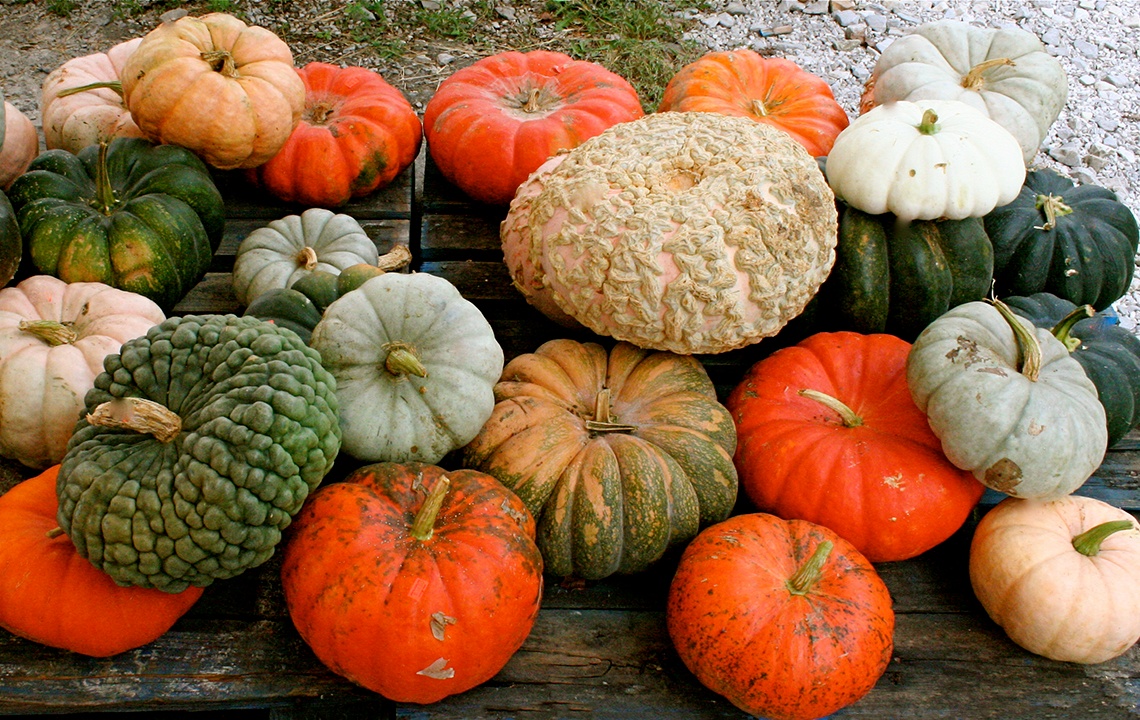You might only be familiar with the round, orange pumpkins that show up everywhere in the fall, but there are many more kinds of pumpkins, ranging in size and color.
“For pottage and puddings and custards and pies, our pumpkins and parsnips are common supplies, we have pumpkins at morning and pumpkins at noon, if it were not for pumpkins we should be undoon.” Pilgrim verse, c. 1633
 While pumpkin spice is quite nice—it is really much more fun to go right to the source! Now, more than ever before, there is an abundance of both decorative and edible pumpkins and winter squashes to select at your local farm or even grocery store. Fueled by a revival in heirloom varieties in recent years, all make beautiful additions to your porch, house or landscape. Or, you can turn them into soups, stews, breads and desserts.
While pumpkin spice is quite nice—it is really much more fun to go right to the source! Now, more than ever before, there is an abundance of both decorative and edible pumpkins and winter squashes to select at your local farm or even grocery store. Fueled by a revival in heirloom varieties in recent years, all make beautiful additions to your porch, house or landscape. Or, you can turn them into soups, stews, breads and desserts.
Pumpkins are a native plant introduced to colonists by the Native Americans (with other varieties later brought from Europe and Asia). Served at the first Thanksgiving, they soon became a reliable crop and winter food source for early New England settlers.
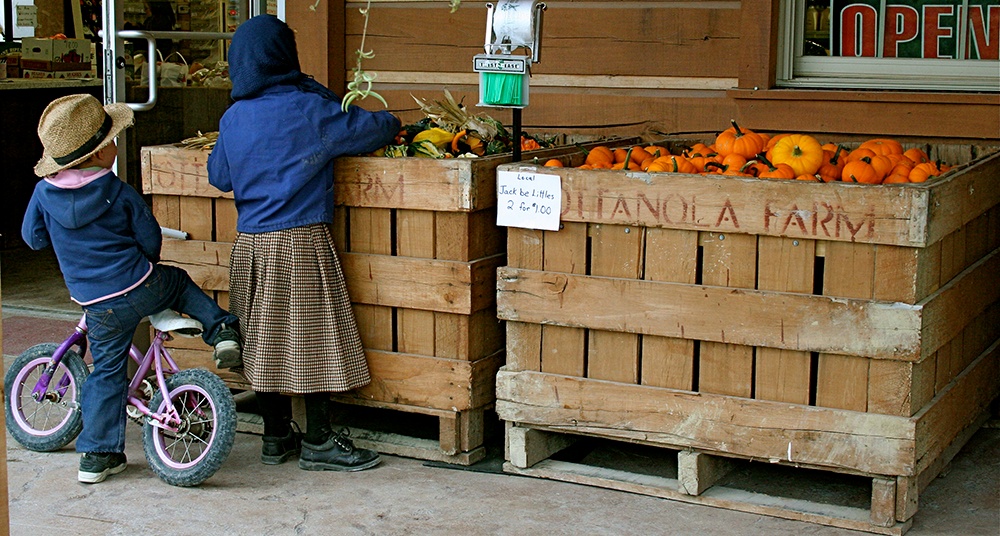 Children inspect bins full of gourds and Jack-be-Little pumpkins at an Old Order Mennonite farm stand.
Children inspect bins full of gourds and Jack-be-Little pumpkins at an Old Order Mennonite farm stand.
Alice Morse Earle, in her well-researched early 20th-century writings on the Colonial period, described an early “pompion” recipe from 1672 that is like a baked and spiced sauce. Our traditional Thanksgiving pumpkin pie possibly originated from the Colonial habit of hollowing out a pumpkin and filling it with milk, spices and honey to be baked in the hot ashes of the fireplace.
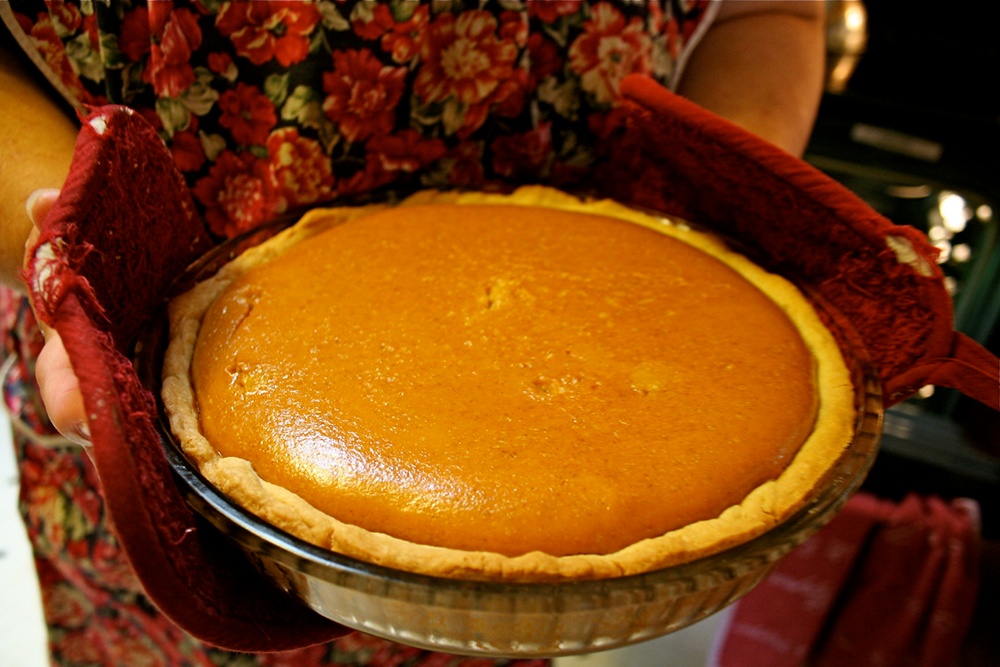 A classic pumpkin pie served at Thanksgiving on the author's farm.
A classic pumpkin pie served at Thanksgiving on the author's farm.
Henry David Thoreau wrote in Wild Fruits that in 1857 he planted six seeds sent to him from France marked “Potiron Jaune Grosse.” From these seeds he got five pumpkins between 123 and 186 pounds. “The big squash took a premium at the Middlesex Show that fall, and I understood that the man who bought it intended to sell the seeds for ten cents apiece,” he said. This is surely the precursor to the kind of giant mammoth pumpkins grown today. On September 4, 1859, Thoreau noted: “Topping the corn, which has been going on some days now, reveals the yellow and yellowing pumpkins. This is a genuine New England scene. The earth blazes not only with sunflowers, but with sun fruits.”
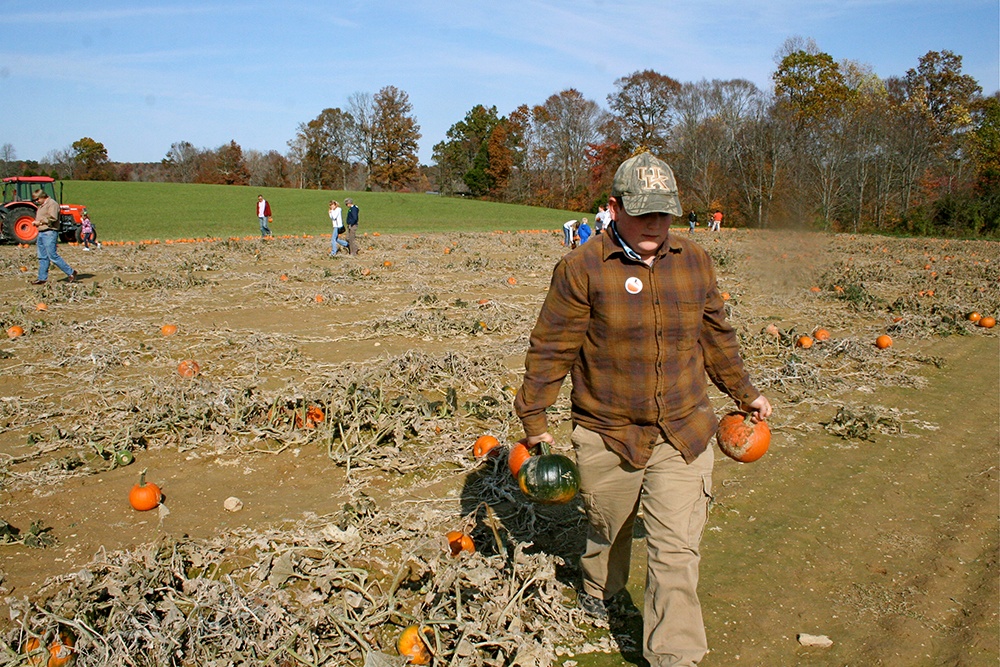 Pumpkin patches are popular agri-tourism destinations during the autumn months.
Pumpkin patches are popular agri-tourism destinations during the autumn months.
Now that we’ve gotten our “pumpkin preamble” out of the way, here’s a partial pictorial guide to the many selections out there. For even more varieties, consult the Heirloom Seed Sources at the end of this article.
So harvest it up with your own stash of pumpkins, gourds, and edible squashes—this is the season, after all. Enjoy it while it lasts! I keep my porch decorations, unless carved, right through Thanksgiving here on our farm.
A Pumpkin Primer
Black Futsu – This is a black Japanese heirloom squash with heavy ribbing, turning to a chestnut color over time.
Baby Boo – Small white pumpkins that are also edible.
Connecticut Field Pumpkin - This is the original heirloom American pumpkin in America and the type Native Americans grew in their corn. Also the first billed as a Halloween pumpkin.

Above: A display of classic and heirloom varieties at a local farm stand. The top row includes three "Connecticut Field" and "Howden" pumpkins, a red and orange "Rouge Vif D'Etampes" (on its side), and two pink "Porcelain Doll" pumpkins. The bottom row includes, from left: a "Musquee de Provence," and two "Speckled Hound" pumpkins in between the field pumpkin
Galeux d’Eysines – This classic heirloom from France (Bordeaux region) is actually a favored edible squash. Collected in 1996 at a pumpkin festival in France, its pinkish flesh covered by distinctive nubby warts is now a more regular feature at farm stands.
Howden – The standard large pumpkin hybrid, developed by John Howden of Massachusetts in the 1970s, has well-defined ribs, a deep orange color, and thick green handles.
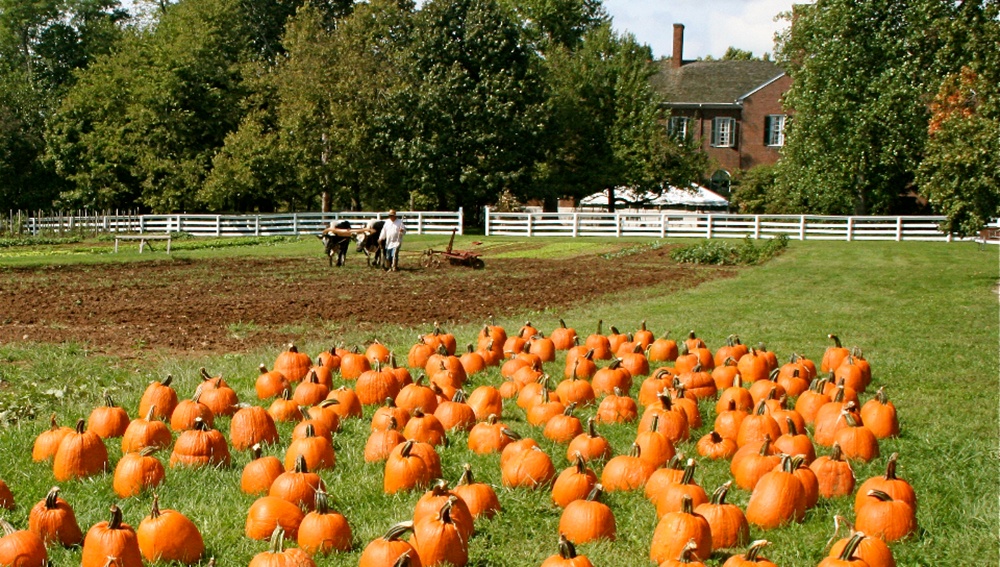 Howden pumpkins grown and on display at Pleasant Hill Shaker Village in Harrodsburg, Kentucky.
Howden pumpkins grown and on display at Pleasant Hill Shaker Village in Harrodsburg, Kentucky.
Jack-be-Little – Miniature orange pumpkins also excellent for eating and stuffing.
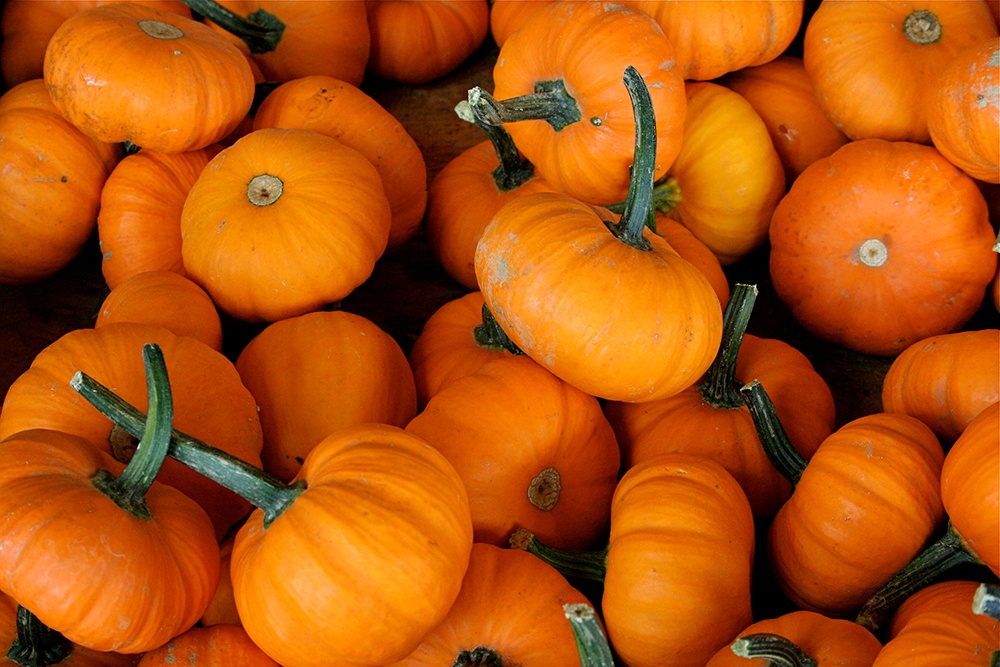 Jack-be-Littles fit in a hand and are also great for stuffing and baking.
Jack-be-Littles fit in a hand and are also great for stuffing and baking.
Jarrahdale – This heirloom from New Zealand is a lovely slate blue with deep ribbing and has among the darkest orange flesh found in any pumpkin. Its dry flesh is also stringless and very flavorable.
 Some "Turk's Turban" squash, left, with light green "Jarrahdale" pumpkins and several "Galeux d'Eysines" (pale orange with warty growths). There is also a large "Cushaw" at right: a popular pie squash.
Some "Turk's Turban" squash, left, with light green "Jarrahdale" pumpkins and several "Galeux d'Eysines" (pale orange with warty growths). There is also a large "Cushaw" at right: a popular pie squash.
Kentucky Field Pumpkin – This c. 10-15 pound heirloom pumpkin is not traditional in shape but was once the industry standard for canning pumpkin and is now quite rare. A prolific yielder, it was also noted for its good winter keeping and for animal forage.
Long Island Cheese – Found in a late 19th century seed catalogue which listed this “large cheese” pumpkin (like a flattened cheese wheel) as “one of the best for table use,” this old heirloom squash from New York also stores well.
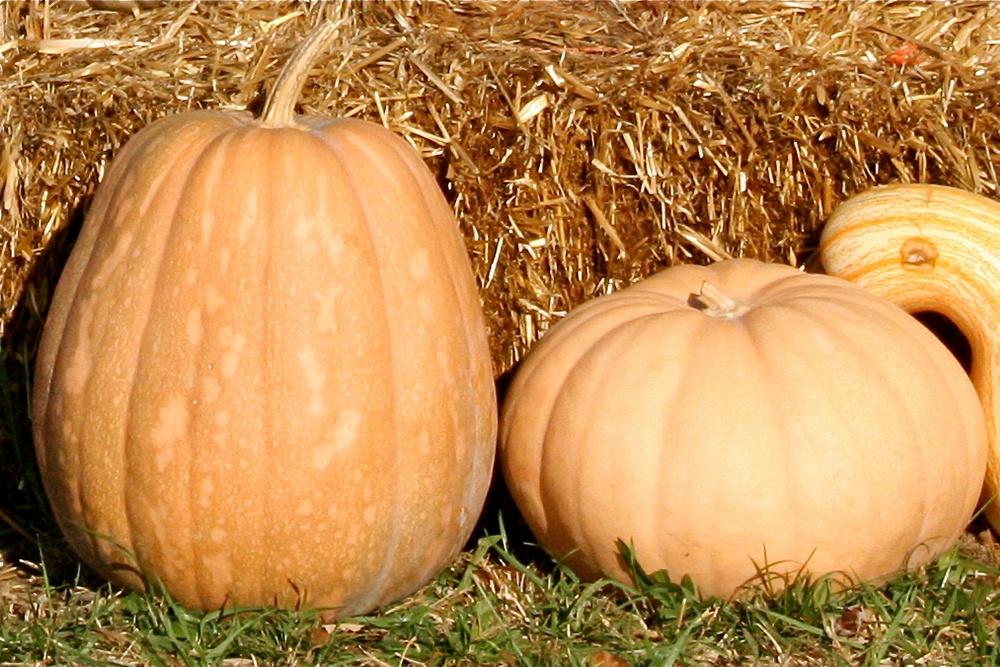
A Kentucky Field Pumpkin, left, and a Long Island Cheese Pumpkin, right.
Marina de Chioggia – This heirloom hails from Chioggia on the coast of Italy. The large turban-shaped fruits are very nubbly and a deep blue-green. The flesh is sweet and ideal in pies.
Musquee de Provence – These are the pumpkins from a fairy tale garden, the kind you could well imagine next to a French castle in the south of France (from whence comes this delightful heirloom). The seed was first sold in America in 1899.
New England Pie – This classic small heirloom sugar pumpkin is a traditional favorite for carving, for canning, or pumpkin pies, due to its thick, sweet flesh.
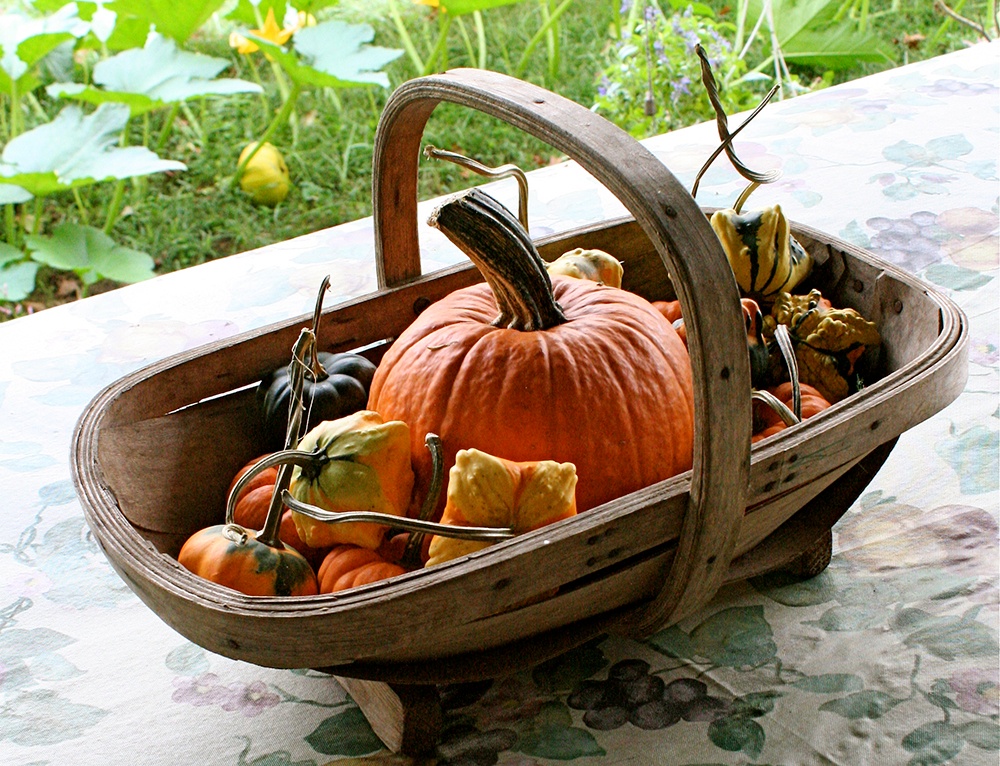 A display of gourds surrounding a "New England Pie" pumpkin.
A display of gourds surrounding a "New England Pie" pumpkin.
Porcelain Doll – This is the world’s first pink pumpkin and a recent hybrid developed by the Pink Pumpkin Patch Foundation as a fund-raiser for breast cancer. It is both decorative and edible with a deep-orange, sweet flesh.
Polar Bear – A large white hybrid variety, similar to the “Lumina” hybrid.
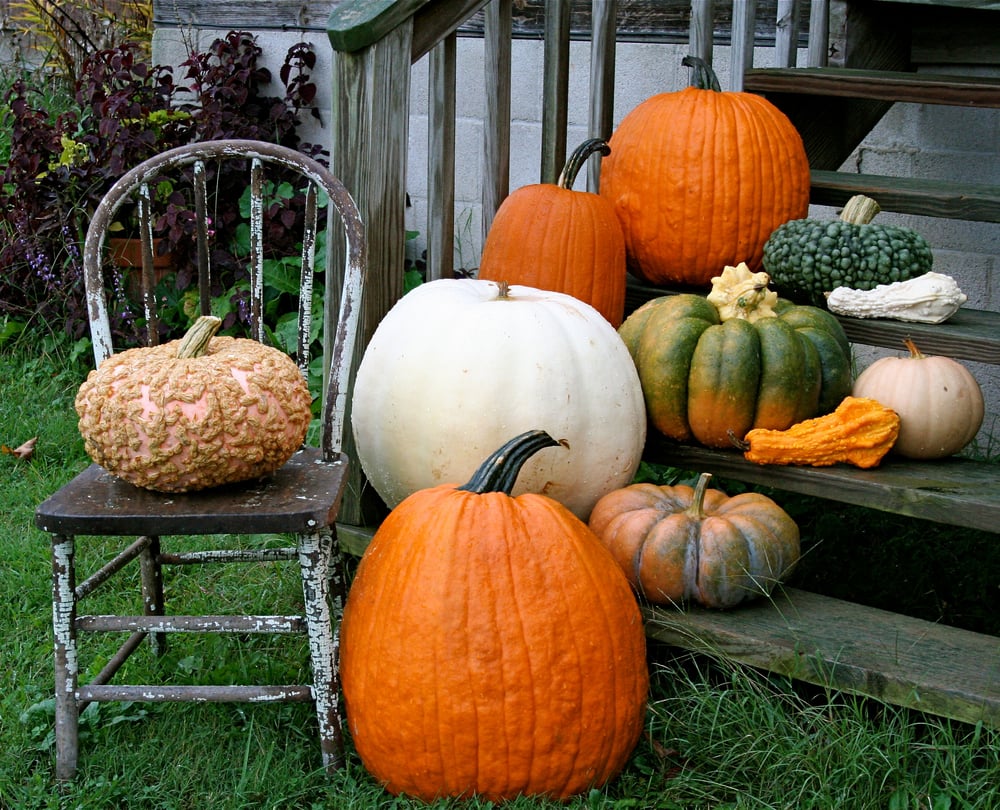 A mixed display of traditional pumpkins and heirlooms on the author's farm porch. Three orange Connecticut Field Pumpkins flank a large white Polar Bear variety, a nubbled green Marina di Chioggia (top), two Musquee de Provence (green and tan), some gourd varieties, and a Galeux d'Eysines on the chair.
A mixed display of traditional pumpkins and heirlooms on the author's farm porch. Three orange Connecticut Field Pumpkins flank a large white Polar Bear variety, a nubbled green Marina di Chioggia (top), two Musquee de Provence (green and tan), some gourd varieties, and a Galeux d'Eysines on the chair.
Rouge Vif D’Etampes – An old French Heirloom, this was the most common pumpkin found in the Central Market in Paris in the 1880s. Its flat and colorful appearance makes it ideal for stacking in outdoor decorations.
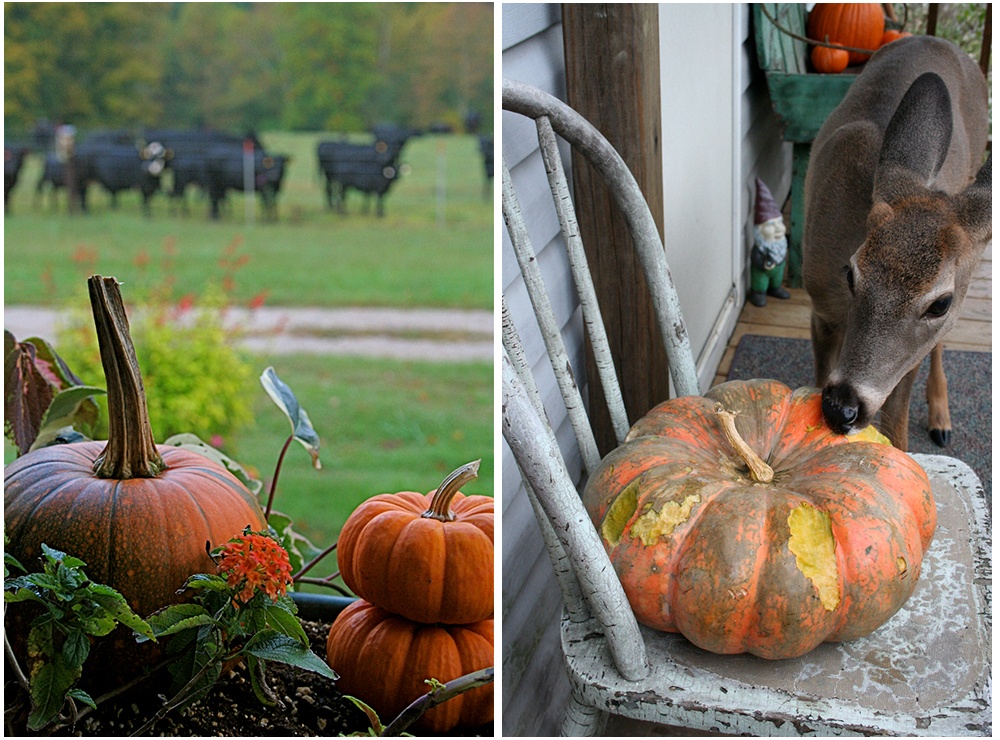 Left: A not-quite-ripened New England Pie Pumpkin and some Jack-be-Littles in a flower box at the author's farm. Right: A deer chomps on a tasty Rouge Vif d'Etampes on the author's porch.
Left: A not-quite-ripened New England Pie Pumpkin and some Jack-be-Littles in a flower box at the author's farm. Right: A deer chomps on a tasty Rouge Vif d'Etampes on the author's porch.
Speckled Hound – This more recent medium-sized hybrid has a nice solid shape with shades of orange and green splotches.
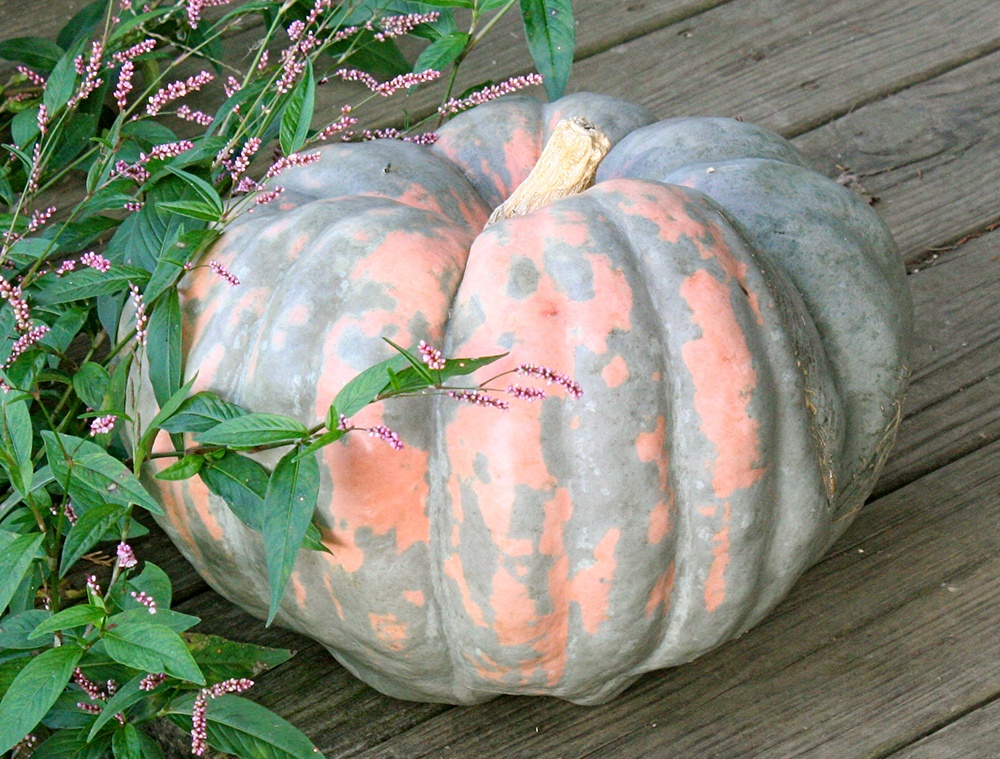 A "Speckled Hound" hybrid is a more recent addition to the pumpkin and squash varieties.
A "Speckled Hound" hybrid is a more recent addition to the pumpkin and squash varieties.
Turk’s Turban - A beautiful and colorful squash that comes from France (pre-1820). Shaped like a turban, it is awash in red, orange, green, and white and is delicious cooked.
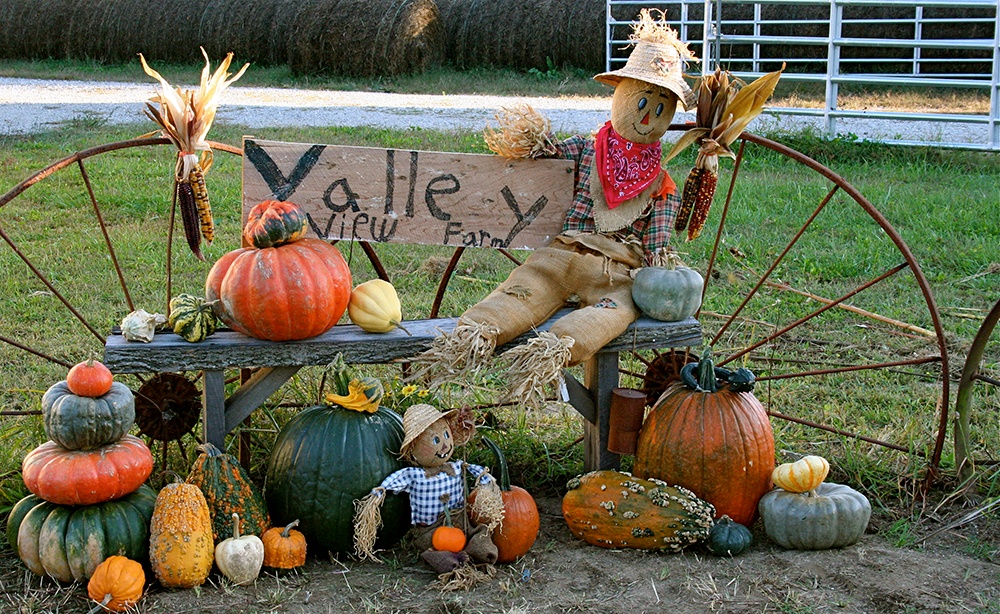
A fall display at the author's farm using a variety of heirloom pumpkins, squash, and gourds.
Heirloom Seed Sources
Many seed catalogues and online sources offer a variety of heirloom and hybrid seeds of the cucurbita family of plants that includes pumpkins, squashes and gourds. Here are some favorites:
- Baker Creek Heirloom Seeds – RareSeeds.com
- Johnny’s Select Seeds – JohnnySeeds.com
- Seed Savers Exchange – SeedSavers.org
- Sustainable Seed Company – SustainableSeedCo.com
- Territorial Seed Company – TerritorialSeed.com
Members of the squash family are among the easiest to grow in any garden. They require a large place where they can sprawl (at least 15x15 if you plan to grow several varieties) and direct sown into hills or rows of amended soil that is rich in humus or composted manure.
You can even throw seeds into an old manure or compost heap and they will thrive. In the fall, dig up your plot, throw fresh manure onto the soil, and then till—by next spring it will be well-composted and ready to plant.
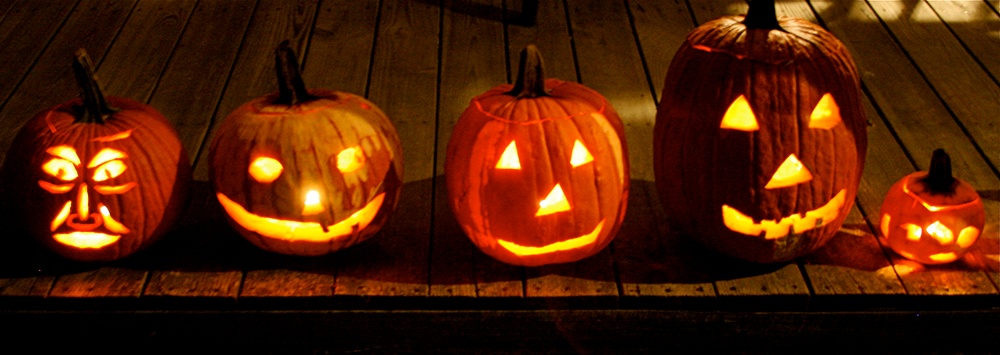
Jack o' Lanterns were originally carved out of turnips in Ireland and the tradition was brought to this country in the late 1800s by Irish immigrants.
Are you looking for the right piece of land to start your country life? View available rural properties throughout the South in Florida, Georgia, Alabama, Louisiana, Mississippi and Texas on our parent company's website, RaydientPlaces.com.
All photos by Catherine Pond.


